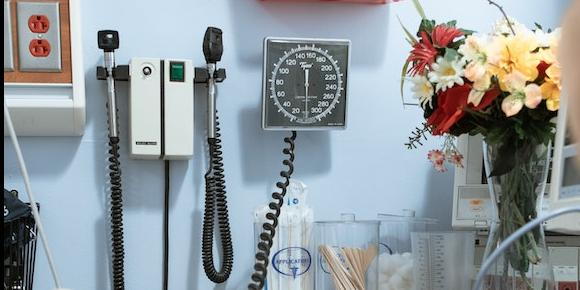Causes and tip for Low Blood Pressure (Hypotension)

- posted: Dec. 09, 2011
Low blood pressure is also called hypotension. We talk about high blood pressure a lot and want to keep our readings low but sometimes too low blood pressure can cause serious problems. Low blood pressure can cause symptoms of dizziness and fainting.
In severe cases, low blood pressure can be life-threatening. Although blood pressure varies from person to person, a blood pressure reading of 90 millimeters of mercury (mm Hg) or less systolic blood pressure (the top number in a blood pressure reading) or 60 mm Hg or less diastolic blood pressure (the bottom number) is generally considered low blood pressure.
What are the causes of Hypotension?
1. Pregnancy. Because a woman's circulatory system expands rapidly during pregnancy, blood pressure is likely to drop. During the first 24 weeks of pregnancy, systolic pressure commonly drops by five to 10 mm Hg and diastolic pressure by as much as 10 to 15 mm Hg. This is normal, and blood pressure usually returns to your pre-pregnancy level after you've given birth.
2. Heart problems. Some heart conditions that can lead to low blood pressure include extremely low heart rate (bradycardia), heart valve problems, heart attack and heart failure. These conditions may cause low blood pressure because they prevent your body from being able to circulate enough blood.
3. Endocrine problems. An underactive thyroid (hypothyroidism) or overactive thyroid (hyperthyroidism) can cause low blood pressure. In addition, other conditions, such as adrenal insufficiency (Addison's disease), low blood sugar (hypoglycemia) and, in some cases, diabetes, can trigger low blood pressure.
4. Dehydration. When you become dehydrated, your body loses more water than it takes in. Even mild dehydration can cause weakness, dizziness and fatigue. Fever, vomiting, severe diarrhea, overuse of diuretics and strenuous exercise can all lead to dehydration. Far more serious is hypovolemic shock, a life-threatening complication of dehydration. It occurs when low blood volume causes a sudden drop in blood pressure and a reduction in the amount of oxygen reaching your tissues. If untreated, severe hypovolemic shock can cause death within a few minutes or hours.
5. Blood loss. Losing a lot of blood from a major injury or internal bleeding reduces the amount of blood in your body, leading to a severe drop in blood pressure.
6. Severe infection (septicemia). Septicemia can happen when an infection in the body enters the bloodstream. These conditions can lead to a life-threatening drop in blood pressure called septic shock.
7. Severe allergic reaction (anaphylaxis). Anaphylaxis is a severe and potentially life-threatening allergic reaction. Common triggers of anaphylaxis include foods, certain medications, insect venoms and latex. Anaphylaxis can cause breathing problems, hives, itching, a swollen throat and a drop in blood pressure.
8. Lack of nutrients in your diet. A lack of the vitamins B-12 and folate can cause anemia, a condition in which your body doesn't produce enough red blood cells, causing low blood pressure. Depending on the reason for your low blood pressure, you may be able to take certain steps to help reduce or even prevent symptoms.
Tips to manage hypotension:
- Drink more water, less alcohol. Alcohol is dehydrating and can lower blood pressure, even if you drink in moderation. Water, on the other hand, combats dehydration and increases blood volume.
- Follow a healthy diet. Get all the nutrients you need for good health by focusing on a variety of foods, including whole grains, fruits, vegetables, and lean chicken and fish. If your doctor suggests using more salt but you don't like a lot of salt on your food, try using natural soy sauce or adding dry soup mixes to dips and dressings.
- Move slowly when changing body positions. You may be able to reduce the dizziness and lightheadedness that occur with low blood pressure on standing by taking it easy when you move from a prone to a standing position. Before getting out of bed in the morning, breathe deeply for a few minutes and then slowly sit up before standing. Sleeping with the head of your bed slightly elevated also can help fight the effects of gravity. If you begin to get symptoms while standing, cross your thighs in a scissors fashion and squeeze, or put one foot on a ledge or chair and lean as far forward as possible. These maneuvers encourage blood to flow from your legs to your heart.
- Eat small, low-carb meals. To help prevent blood pressure from dropping sharply after meals, eat small portions several times a day and limit high-carbohydrate foods such as potatoes, rice, pasta and bread. Your doctor also may recommend drinking caffeinated coffee or tea with meals to temporarily raise blood pressure. But because caffeine can cause other problems, check with your doctor before drinking more caffeinated beverages.
Dr. Amie Gregory, DC, CCEP, ANF is a San Francisco, CA and San Carlos, CA chiropractor that understands full body health. She works with athletes, expectant moms, office workers and everyone else in between. Contact our San Francisco, CA chiropractic office or San Carlos, CA chiropractic office today!
Location
Find us on the map - Please click desired location below
Precise Moves Chiropractic San Francisco
3150 18th Street, Suite 334
San Francisco, CA 94110, United States
24 hour Scheduling makes it easy!
(Hours may change due to doctor availability)
Hours in the mission district, San Francisco
8-12pm
Closed
3-6PM
8-12PM
3-8PM
8:00 am - 12:00 pm
Closed
